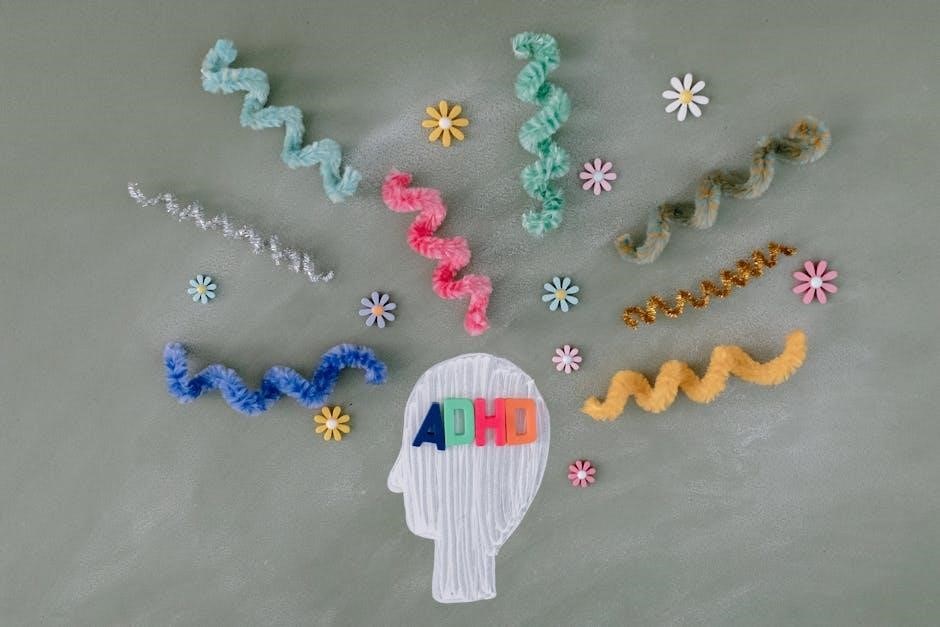Attention Deficit Disorder (ADD) is a neurodevelopmental condition characterized by persistent inattention, hyperactivity, and impulsivity, impacting learning, daily functioning, and relationships across all age groups.
1.1 Definition and Overview
Attention Deficit Disorder (ADD) is a neurodevelopmental condition marked by persistent patterns of inattention, hyperactivity, and impulsivity. It significantly impacts daily functioning, learning, and relationships. ADD, now often referred to as ADHD (Attention-Deficit/Hyperactivity Disorder), affects approximately 5-8% of children and some adults. Symptoms vary widely, but inattention is the hallmark, often interfering with tasks and social interactions, as outlined in DSM-5 criteria.
1.2 Historical Perspective and Evolution of Understanding
Historically, attention deficit disorder was first recognized in the early 20th century, with Sir George Still describing hyperactive children in 1902. The DSM-I (1952) introduced “hyperkinetic disorder,” while DSM-II (1968) labeled it “hyperkinetic reaction.” The term “Attention Deficit Disorder” emerged in DSM-III (1980), with DSM-5 (2013) refining criteria to include three subtypes: predominantly inattentive, hyperactive-impulsive, and combined presentation, acknowledging its persistence into adulthood.

Symptoms of Attention Deficit Disorder
Symptoms include inattention (e.g., difficulty staying focused), hyperactivity (e.g., excessive movement), and impulsivity (e.g., interrupting others). These traits disrupt daily life, affecting both children and adults.
2.1 Inattention Symptoms
Inattention symptoms include difficulty staying focused, forgetting tasks, and being easily distracted. Affected individuals often struggle with completing assignments, following instructions, and maintaining attention during activities. They may appear disorganized, lose items frequently, and avoid tasks requiring sustained mental effort. These symptoms are often noticeable in both children and adults, impacting daily activities and academic or occupational performance significantly.
2.2 Hyperactivity Symptoms
Hyperactivity symptoms involve excessive restlessness and an inability to remain still. This may manifest as fidgeting, constantly moving, or feeling an internal urge to be in motion. In adults, hyperactivity can appear as feelings of restlessness or an inability to relax, while in children, it often results in running, climbing, or talking excessively, even in inappropriate settings.

2.3 Impulsivity Symptoms
Impulsivity symptoms involve acting without thinking, interrupting others, and difficulty waiting one’s turn. This may lead to hasty decisions, impulsive spending, or risky behaviors. In children, impulsivity often results in blurting out answers or interrupting conversations. In adults, it can manifest as impatience or making reckless choices, disrupting personal and professional relationships and daily functioning.

Diagnosis and Assessment
Diagnosis and Assessment of ADHD involve a clinical evaluation of current and past symptoms, functional impairment, and family history to confirm the condition.
3.1 Diagnostic Criteria and DSM-5 Updates
The DSM-5 updated ADHD diagnostic criteria in 2013, allowing for a better understanding of the disorder. Key changes include raising the age cutoff for symptom onset to 12 years and recognizing that adults can have ADHD. The criteria emphasize persistent inattention and/or hyperactivity-impulsivity across settings, requiring at least five symptoms in each category for diagnosis, ensuring accurate assessment and reducing misdiagnosis.
3.2 Challenges in Diagnosing ADHD in Adults and Children
Diagnosing ADHD in both adults and children presents unique challenges. In adults, symptoms like inattention and impulsivity can overlap with other mental health disorders, making differential diagnosis difficult. For children, distinguishing ADHD from typical developmental behaviors is complex. Additionally, diagnostic assessments rely heavily on subjective reports from parents and teachers, which may vary in accuracy, leading to potential misdiagnosis or delayed identification of the condition.

Causes and Risk Factors
ADHD is linked to genetic, neurobiological, and environmental factors. Brain structure differences, family history, and prenatal exposures contribute to its development, influencing symptom severity and manifestation.
4.1 Genetic and Neurobiological Factors
Research indicates that ADHD has a strong genetic component, with certain gene variants affecting brain structure and dopamine regulation. Neurobiological studies suggest differences in prefrontal cortex activity and neurotransmitter function contribute to inattention and hyperactivity. Family history significantly increases risk, while brain imaging reveals distinct patterns in individuals with ADHD, supporting its biological basis and genetic predisposition.
4.2 Environmental and Lifestyle Influences
Environmental factors, such as prenatal exposure to smoking or alcohol, and dietary influences, may contribute to ADHD symptoms. Family dynamics, parenting styles, and socioeconomic status also play a role. Additionally, lifestyle factors like sleep deprivation, physical activity levels, and screen time have been linked to symptom severity, highlighting the interplay between biological and environmental elements in shaping the disorder’s expression.
Treatment and Management
Treatment involves a combination of medications, behavioral therapies, and lifestyle adjustments to manage symptoms and improve functioning in daily life.
5.1 Medications and Pharmacotherapy
Medications, such as stimulants (e.g., Ritalin, Adderall) and non-stimulants (e.g;, Strattera), are commonly prescribed to manage ADHD symptoms by improving focus and reducing hyperactivity and impulsivity.
Pharmacotherapy is often combined with behavioral therapies and lifestyle changes to create a comprehensive treatment plan tailored to individual needs and responses to medication.

5.2 Behavioral Therapies and Lifestyle Changes
Behavioral therapies, such as cognitive-behavioral therapy (CBT) and behavioral modification, help individuals with ADHD manage symptoms by teaching coping strategies and improving self-regulation.
Lifestyle changes, including structured routines, a balanced diet, regular physical activity, and stress management, can complement therapy and improve overall functioning and well-being in individuals with ADHD.

Impact on Daily Life and Relationships
ADHD significantly affects daily functioning, relationships, and quality of life, often leading to challenges in education, employment, and social interactions due to inattention and impulsivity.
6.1 Educational and Occupational Challenges
Individuals with ADHD often face significant challenges in educational and occupational settings due to difficulties with focus, organization, and task completion. In schools, this may lead to poor academic performance, while in the workplace, it can result in lower job satisfaction and strained relationships with colleagues. These challenges can create a cycle of underachievement and frustration, impacting long-term career growth and personal development.
6.2 Social and Family Dynamics
Attention Deficit Disorder often disrupts social and family dynamics, as individuals may struggle with impulsivity, interrupting conversations, and meeting expectations. Families may misinterpret symptoms as intentional behavior, leading to frustration. Social relationships can suffer due to difficulties with focus and follow-through, creating feelings of isolation. Understanding and empathy are crucial to fostering supportive environments and improving interpersonal connections.

Recent Research and Developments
Recent studies highlight advancements in ADHD diagnosis, including improved screening tools and biomarkers. Emerging therapies focus on personalized treatments, while research continues to explore genetic and environmental influences.
7.1 Advances in Diagnostic Methods
Recent advancements in diagnostic methods for ADHD include the use of biomarkers, neuroimaging, and computerized screening tools. These innovations aim to enhance accuracy and early detection, reducing reliance on subjective assessments. Additionally, machine learning algorithms are being explored to improve diagnostic reliability and personalize treatment approaches for individuals with ADHD.
7.2 Emerging Therapies and Treatments
Emerging therapies for ADHD include non-pharmacological approaches like cognitive training, mindfulness-based interventions, and neurofeedback. These methods aim to improve attention and reduce impulsivity. Additionally, researchers are exploring advanced pharmacological options, such as personalized medications tailored to genetic profiles, and extended-release formulations to enhance efficacy and reduce side effects, offering hope for more effective and targeted treatments.

Cultural and Societal Perspectives
Cultural differences influence ADHD diagnosis and perception, with some societies stigmatizing it, while others are more accepting. Public awareness campaigns help reduce stigma and promote understanding.
8.1 Cultural Differences in Diagnosis and Perception
Cultural differences significantly influence how ADHD is perceived and diagnosed. In some cultures, symptoms like hyperactivity may be normalized or viewed as typical childhood behavior, leading to underdiagnosis. Conversely, in cultures with strict academic expectations, inattention might be more readily identified. Language barriers and varying diagnostic criteria across regions further complicate accurate identification and understanding of ADHD.
8.2 Stigma and Public Awareness
Stigma surrounding ADHD persists due to misunderstandings and lack of awareness. Many view it as a result of poor parenting or lack of discipline, rather than a neurodevelopmental disorder. Public awareness campaigns aim to educate communities, reduce stigma, and promote acceptance. Increasing understanding fosters supportive environments, encouraging individuals to seek help without fear of judgment.
Early diagnosis and comprehensive support are crucial for managing ADHD. Future research should focus on improving treatment options and reducing stigma through public awareness campaigns.
9.1 Summary of Key Findings
Attention Deficit Hyperactivity Disorder (ADHD) is a common neurodevelopmental disorder marked by inattention, hyperactivity, and impulsivity. It affects 5-8% of children and often persists into adulthood. Early diagnosis and intervention are critical, with treatments including medications and behavioral therapies. The DSM-5 updated diagnostic criteria to better characterize symptoms. ADHD impacts education, workplace productivity, and relationships, emphasizing the need for comprehensive support and awareness to improve outcomes and reduce stigma.
9.2 Future Research and Advocacy Needs
Future research should focus on personalized treatments, long-term outcomes, and neurobiological mechanisms. Advocacy efforts are needed to reduce stigma, improve public awareness, and enhance access to care. Encouraging early diagnosis and promoting inclusive educational and workplace environments remain critical. Continued collaboration between researchers, clinicians, and policymakers is essential to address the evolving needs of individuals with ADHD across their lifespan.













































































